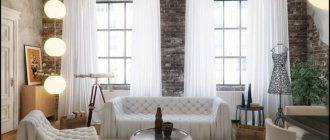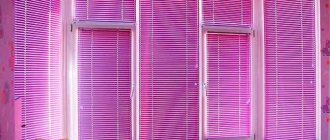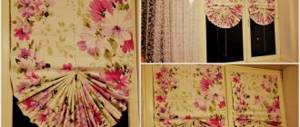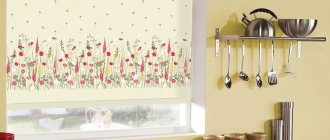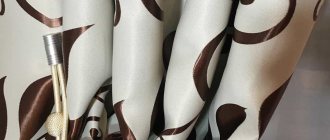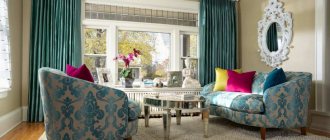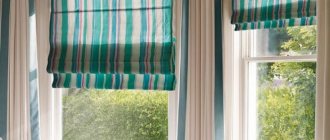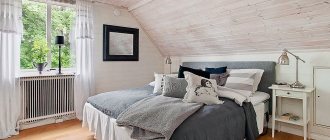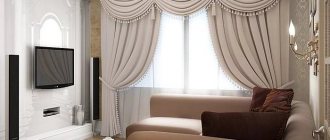Rules for perfect curtains
Curtains for loggias and balconies are not just window decoration and protection from street light, they are a completely special design element. Many laws for ordinary curtains in the kitchen or bedroom do not apply to them, so when choosing, you need to take into account several important nuances.
Beautiful curtains or blinds will give the balcony a cozy look
Which side do the windows face? If your balcony faces south and the sun floods the room in both winter and summer, choose thick fabric that will block the light. For the cold, sunny side, light curtains, including organza and tulle, are suitable.
Features of the premises. The loggia is the border between the apartment and the street; there is always more dust and moisture here, especially if you are a lover of open windows and fresh air.
When planning your curtain design, avoid luxurious multi-layer curtains with lambrequins and ruffles; such designs will turn into dust collectors.
The balcony option includes environmentally friendly fabrics and laconic design solutions, such as bamboo, linen and reed.
Balcony dimensions. Thick curtains will look inappropriate on a small balcony, but Roman and roller curtains are perfect here. In the interior of a spacious, light loggia, Japanese curtains and long transparent curtains will be stylish and harmonious.
Fabric color. There is one strict taboo for balcony curtains - the dark color of the fabric. Such curtains do not fit well into the interior and absorb a lot of sun, which is why you risk getting a small sauna instead of a cozy room. Choose light colors - they go with any decor and create a cool climate.
For balcony rooms, experts recommend several design options - horizontal blinds, roller blinds, Roman and Japanese blinds. This is due to the installation features: classic curtains are attached to a curtain, which requires free space between the upper border of the window and the ceiling. But on balconies this is not always possible, so it is better to choose structures that are installed directly on the window sash.
The color of the curtains should be in harmony with the interior
The nuances of choosing curtains for the balcony
It often happens that balconies and loggias have non-standard sized windows. Therefore, regular store-bought curtains may not be suitable; this must be taken into account when choosing. It is best to measure the length of the window in advance and select curtains according to it. Another option is to order custom tailoring of the curtains you like in the salon.
Since balconies are most often very limited in space, curtains that are too voluminous and lush are not suitable for their decoration. Heavy curtains with lambrequins will also look inappropriate. Therefore, it is worth paying attention to the simplest and most direct models.
You also need to take into account that long curtains can make it difficult to access the windows, so if you often ventilate the room, you need to take care of an additional fastener that can collect the curtains on the sides of the windows.
It is not recommended to use one wide curtain if several blocks with windows are used on the balcony. This will make accessing them much more difficult. Therefore, a good option would be to use two separate curtains on a small balcony and three on a long one.
It is important to consider the degree of illumination of the balcony. If it is located on the south side, then the fabric can quickly fade under the intense rays of the sun. Therefore, in this case, thicker fabrics for curtains will suit you. But on the north side it is better to use translucent and transparent, lightweight fabrics that do not completely block the access of light to the balcony.
Blinds
Horizontal blinds are a proven and convenient option for decorating a balcony. This design has been used for a long time and has gained many fans, especially since almost all the shortcomings of horizontal blinds are easy to correct.
Pros:
- wear resistance: profiles are not afraid of temperature fluctuations and water, the enamel does not wear off and is practically not scratched;
- can be mounted on a wall, in a window opening or separately on each sash;
- goes well with tulle and light curtains;
- The panels (lamellas) rotate 360 degrees: it is possible to adjust the lighting.
Minuses:
- not suitable for sliding windows;
- slightly limit the degree of opening of the valves;
- in drafts they can ring (corrected by installing lower fasteners);
- plastic lower fasteners break if handled carelessly (soft propylene ones are a worthy replacement);
- If several lamellas are damaged, the entire structure needs to be replaced.
Blinds are wear-resistant and durable
Roman curtains
Roman blinds for the balcony (or Romanesque) are curtains made of solid fabric, which, when assembled, gather into spectacular even folds of 20-30 centimeters. Romanesque curtains can be of two types: manually operated (cord or chain) and electrically operated.
Pros:
- practicality: resistant to stains and will last for many years;
- save precious balcony space;
- easy to hang, and can be fixed in places where ordinary curtains “will not fit”: not only a balcony window, but also a shallow niche in the wall;
- go well with tulle, this allows you to adjust the lighting and creates a unique coziness;
- varied curtain designs: Roman design fits into any style, from country and strict classics to eclecticism.
There are no tangible disadvantages to Roman blinds for balconies; it is only important to follow a few rules: choose a light-colored fabric, avoid large, colorful patterns in small rooms, and take into account the design of neighboring rooms when purchasing fabric.
When it comes to hanging Roman curtains yourself, there are usually no difficulties. It is necessary to decide on the type of control: cord, electric or rotary-chain, and then install the mechanism on the screws. It can be mounted either on the wall above the sash, or on the internal window opening. After this, the fabric is attached.
Roman blinds are beautiful and unusual
Why do you need curtains for a window with a balcony door?
Often the living room in apartments borders on the balcony area. It can be difficult to decorate this part of the living room, because incorrectly selected curtains for windows with a balcony door will immediately ruin the entire impression of the room.
Curtains should:
- Be practical;
- Do not burn out in the sun;
- Do not obstruct access to the balcony.
Many people use the loggia as a greenhouse in the warm season, so that the plants are not destroyed by excessive amounts of sunlight, they hang curtains.
Some even use the balcony as a personal office or sleeping place, placing a folding bed there. It’s not a bad idea if it’s not possible to go on vacation in the summer: you can imagine that you are lying and sunbathing on a beach lounger, the noise of cars will pass for the sounds of the surf, and the screams of children on the playground will pass for the screams of seagulls, and light curtains will prevent you from getting sunburned.
Usually, practical options such as blinds, roller blinds and Roman blinds are used for a window with a balcony door. They meet all the above requirements for curtains. The only drawback is their excessive formality, which is suitable only for minimalist interiors. However, this problem can be solved with the help of additional decor.
Roller blinds
This design is sometimes called roller blinds - when opened, the fabric is rolled into a roll or hidden in a special box. The canvases are attached separately to each window sash and allow you to completely darken the room if necessary, unlike traditional blinds.
Roller blinds come in a huge variety of not only colors and textures, but also several varieties that differ in price and mounting system.
The simplest and most budget-friendly is the Mini system, which consists of a canvas and a mounting shaft into which the curtain is wound. These curtains are quite easy to make with your own hands. The design of Uni1, Uni2 and Rollite (roller-cassette blinds) includes a special cornice in the form of a compact box or cassette where the balcony blind is hidden.
Pros:
- resistance to dust, rain and bright sun;
- can be installed on windows made of any materials: wood, plastic, aluminum;
- variety of colors and fabrics;
- ease of operation;
- large price range;
- easy to care for (dry clean or wet wipes).
Minuses:
- reduce the opening angle of the valves;
- for roller-cassette varieties of roller blinds, when installed on a window, the box takes about 5 centimeters of glass;
- Uni1, Uni2 and Rollite systems are not suitable for sliding sashes.
The solution to the problem of how to hang roller blinds with your own hands depends on the type of construction. The Mini system mounting bracket can be installed in three ways: with self-tapping screws, on a spring bracket (metal or plastic) or with tape.
Installation of the Uni roll system consists of several stages: first we install the cornice along with the fabric on the screws, then we glue the side guides. We lower the blade to the desired level and install a control chain limiter.
Roller blinds are convenient
Japanese curtains
Japanese curtains (Japanese blinds) are the personification of Asian laconicism and severity in the balcony interior. They consist of several canvases that are attached to a special cornice and move along horizontal guides. The difference between Japanese curtains and standard vertical blinds is that the panels of such designs do not rotate, and the width is much greater than that of traditional rigid curtains.
Japanese blinds are made according to a special standard: the length of the cornice is no more than 6 m, the width of one panel is from 0.2 to 1.5 m, the number of panels in one row is from 3 to 6.
Pros:
- wide selection of colors, fabrics and combinations;
- protection from dust and light;
- practicality: if one fabric panel fails, it can always be replaced with another;
- ease of installation: the cornice is attached to a special tape, and at any time you can replace the curtains with new ones, leaving the same fittings;
- variety of design solutions: Japanese blinds are suitable for balcony windows and doorways, they will help to divide a large room into zones (for example, if the loggia is connected to the living room).
The main disadvantage of Japanese curtains is that they are not recommended for hanging on small balconies; these designs are intended only for spacious loggias with large windows. In such rooms they look most impressive.
Japanese curtains are unusual and elegant
Practical beauty
In most apartments and houses, the design with a balcony door includes 2 or 3 windows. They are often the only source of sunlight in the room. In this case, curtains for a living room with a balcony should not be thick. You will only have to think about saving yourself from bright sunlight if the balcony is not glazed and the wide windows face the south side. It is better to choose curtains for a room with a balcony so that they can be adjusted, darkening or brightening the room.
Sometimes the loggia plays the role of a separate room: people rest on it, store things, and hang laundry. If this part of the apartment is used by each family member quite often, then it is worth taking care of the quality of the fabric. It is better to choose a wear-resistant one that can be easily washed. It’s even better to leave the entrance as free as possible, because the curtains will not last long if they are constantly touched by hands, thrown over the door, laid on the radiator, etc.
Textiles for a window with a balcony door are exposed to the sun almost all day, so the fabric runs the risk of quickly fading. This is especially true for natural fabrics, as well as cheap synthetics. Textiles that do not deteriorate due to temperature changes and can be easily cleaned on the spot or in a washing machine are especially necessary in a room with a balcony. Now there are many good artificial materials, such as nylon, acrylic, polyester, etc. A good option would be a combined fabric, when natural materials are mixed with synthetic ones. The same linen or cotton becomes more resistant to wear, exposure to sunlight and chemicals.
You may also be interested in: Black color in the interior
Save
Save

